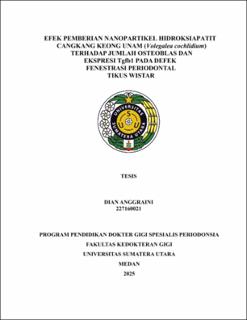| dc.description.abstract | Background: Periodontal disease can cause significant alveolar bone damage and may also lead to tooth loss. Periodontal treatment can involve surgical procedures aimed at regenerating all tissues damaged by the disease. Several surgical techniques have been developed in an effort to achieve predictable periodontal tissue regeneration, one of which is Guided Tissue Regeneration (GTR). An indication for GTR surgery is the presence of periodontal defects that will provide space for the placement of bone graft material. In recent decades, a substantial amount of research has focused on the creation of bioceramics utilizing biological waste, such as seashells, as bone graft materials. Unam (Volegalea cochlidium) seashells belong to the gastropod class and have a high calcium carbonate content, making them a potential calcium source for the synthesis of hydroxyapatite, which has properties nearly identical to the inorganic component of the bone matrix. Objective: To analyze the effectiveness of administering Unam conch shell hydroxyapatite nanoparticles on number of osteoblast and Tgfb1 expression in wistar rat periodontal fenestration defects. Methods: Experimental laboratory research in vivo with post-test control group design of 45 male Wistar rats aged 2-3 months in six sample groups, namely fenestration defects without bone grafting material placement, but with the administration of polyethylene glicol (PEG) conductor material, with the administration of Bonefill, with the administration of nHAp Unam conch shells (Volegalea Cochlidium) concentrations of 1%, 2%, 4% and 100% then immunohistochemistry examination was carried out. Results: The results showed that the highest number of osteoblast cells was in the treatment group given nHAp of unam snail shells at a concentration of 4% and the average value of Tgfb1 expression was obtained by administering nHAp of Unam snail shells at a concentration of 4% on the 14th day, which was 6.33±1.15 approaching the positive control value on the 14th day, which was 7.00±0.00, followed by concentrations of 2%, 100%, 1% and the lowest value in the negative control. Conclusion: The highest number of osteoblast cells and Tgfb1 expression was obtained in the treatment group of nHAp administration of Unam conch shells (Volegalea Cochlidium) on the 14th day. This shows that this material can increase the activity of osteoblasts that proliferate and differentiate. | en_US |


